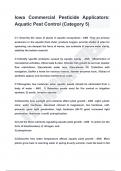FLYINGHIGHER
Iowa
Commercial
Pesticide
Applicators:
Aquatic
Pest
Control
(Category
5)
C1:
Describe
the
value
of
plants
in
aquatic
ecosystems
-
ANS
They
are
primary
producers
in
the
aquatic
food
chain,
produce
oxygen,
provide
shelter
&
sites
for
spawning,
can
dampen
the
force
of
waves,
use
nutrients
&
improve
water
clarity,
stabilize
the
bottom
material
C1:Identify
specific
problems
caused
by
aquatic
weeds
-
ANS
1)Restriction
of
recreational
activities,
2)foul
taste
&
odor,
3)hinder
fish
growth
&
survival,
4)water
flow
restrictions,
5)accelerate
water
loss,
6)accelerate
fill,
7)interfere
with
navigation,
8)offer
a
home
for
noxious
insects,
9)water
becomes
toxic,
10)loss
of
aesthetic
appeal,
and
increase
maintenance
costs.
C1:Recognize
two
instances
when
aquatic
weeds
should
be
eliminated
from
a
body
of
water
-
ANS
1)
Retention
ponds
used
for
fire
control
or
irrigation
systems;
2)
exotic,
invasive
species
C2:Describe
how
sunlight
and
nutrients
affect
plant
growth
-
ANS
Light:
photic
zone;
water
hardness-
dissolved
calcium
&
magnesium,
low
hardness,
soft,
prevents
good
light
penetration,
high
hardness
(60-75
ppm)
increased
light
penetration.
Nutrients:
runoff;
eutrophication.
C2:List
the
three
nutrients
regulating
aquatic
plant
growth
-
ANS
1)
carbon
(in
the
form
of
bicarbonates),
2)
nitrogen,
and
3)
phosphorus
C2:Describe
how
water
temperature
affects
aquatic
plant
growth
-
ANS
Most
plants
grow
best
in
warming
water
in
spring
&
early
summer,
most
die
back
in
fall FLYINGHIGHER
as
water
cools,
some
grow
best
in
late
winter
&
spring
(curlyleaf);
a
few
later
in
summer
(naiads)
C2:Explain
why
sand
is
a
good
substrate
in
small
bodies
of
water,
but
bad
in
rivers
-
ANS
Rivers
sand
shifts,
ponds
it
doesn't
matter
C2:Explain
why
rock
and
gravel
substrates
are
not
conducive
to
growth
of
rooted
plants
-
ANS
They
provide
little
in
the
way
of
fertile
sediments
for
nutrient
uptake
C3:Identify
three
major
types
of
algae
-
ANS
1)
microscopic,
2)
filamentous,
3)
stonewarts
(Nitella
&
Chara)
C3:Differentiate
between
the
four
types
of
flowering
plants
based
on
the
habitat
they
occupy
in
the
aquatic
environment
-
ANS
1)
submersed
plants-
water
depths
of
less
than
1
foot
to
20
feet,
2)
free-floating
plants-
water
surface
(duckweed),
3)
rooted
floating
plants-
water
depths
of
1
to
5
feet
(water
lotus,
pondweed),
4)
emergent
plants-
water
depths
less
than
3
feet
C3:List
four
types
of
leaf
arrangement
that
aid
in
the
identification
of
submersed
plants
-
ANS
1)
alternate
leaf
arrangement-
one
leaf
per
node
(pondweed),
2)
opposite
leaf
arrangement-
two
leaves
per
node
(naiads),
3)
whorled
leaf
arrangement-
three
or
more
leaves
per
node
(coontail
&
elodea),
&
4)
basal
leaf
arrangement-
does
not
have
an
erect
stem
(eelgrass)
C3:Discuss
why
duckweed
can
be
especially
problematic
in
a
water
body
-
ANS
Can
completely
cover
the
surface
and
cause
the
bottom
layer
of
water
to
become
anaerobic
&
unsuitable
for
fish
C3:Identify
the
location
of
leaf
emergence
for
rooted
floating
plants
-
ANS
Underground
or
in
sediment
(rhizomes)-
American
lotus,
spatterdock,
water
lily,
water
shield;
From
stems-
pondweeds FLYINGHIGHER
C3:Distinguish
the
two
types
of
emergent
plants
and
give
an
example
of
each
-
ANS
1)
herbaceous-
grass-like
plants
(cattail,
bulrush),
plants
with
broad
leaves
(arrowhead,
smartweed);
2)
woody
plants-
(willow,
buttonbush)
C4:Identify
three
major
objectives
in
preventive
aquatic
plant
control
-
ANS
1)
prevention
of
weed
spread,
2)
elimination
of
nutrient
sources
that
support
growth,
and
3)
reduction
of
shallow
areas
where
plants
can
root
C4:List
the
seven
steps
to
reducing
nutrient
input
through
a
watershed
management
plan
-
ANS
1)
install
sod
or
native
grasses/vegetation
along
drainage
areas
&
buffers,
2)
stop
fertilizing
grass
in
a
10
to
20
foot
strip
along
a
body
of
water,
3)
prevent
livestock
from
entering
water,
4)
practice
conservation
tillage
in
watershed
areas
that
are
subject
to
erosion,
5)
construct
a
settling
or
retention
basin
to
receive
nutrients
before
they
reach
the
main
body
of
water,
6)
avoid
the
addition
of
fertilizer
directly
to
a
pond,
and
7)
check
for
hidden
sources
of
nutrients
such
as
septic
fields
&
drainage
tiles
C4:Discuss
how
to
eliminate
shallow
areas
of
ponds
and
lakes
for
existing
and
new
construction
sites
-
ANS
New
ponds
should
be
constructed
so
that
shoreline
edges
have
a
3
to
1
bank
slope
to
reduce
areas
for
rapid
plant
establishment,
not
in
swimming
areas;
existing
ponds
or
lakes-
dredges
or
draglines,
also
maintenance-
which
may
involve
rehabilitation
and
draining
&
then
excavate
and
shape
C4:Describe
two
types
of
equipment
used
for
mechanical
aquatic
weed
control
and
their
advantages
and
disadvantages
-
ANS
1)
dragline-
effective,
expensive
&
must
be
repeated
every
few
years,
2)
weed
harvesters-
Advantages:
removes
all
types
of
aquatic
vegetation,
no
restrictions,
can
cut
fishing
&
boating
lanes,
plant
material
not
left
in
water
to
decompose
&
possibly
cause
fish
kills,
removing
plant
materials
aids
in
removing
nutrients,
Disadvantages:
high
equipment
&




